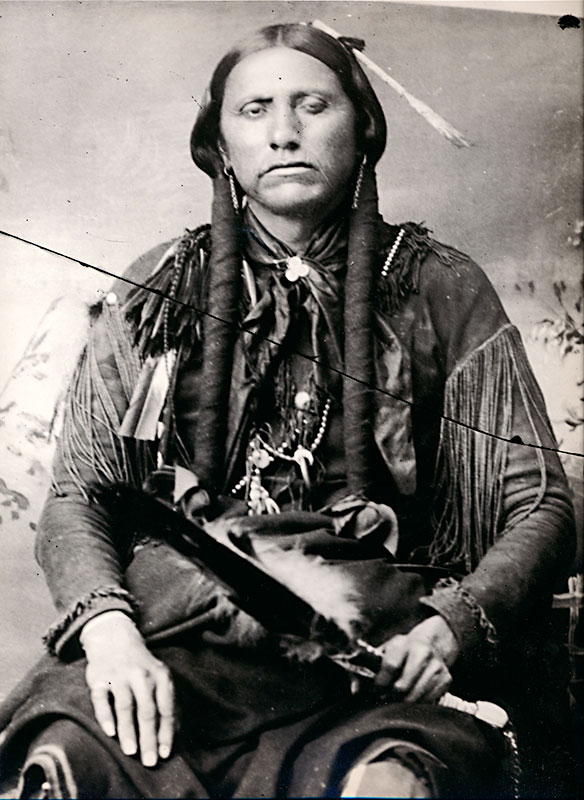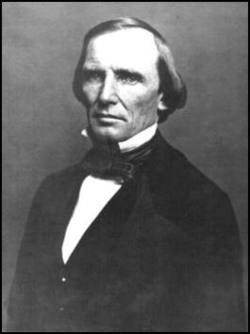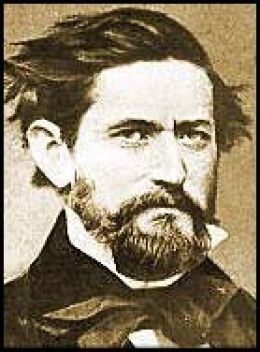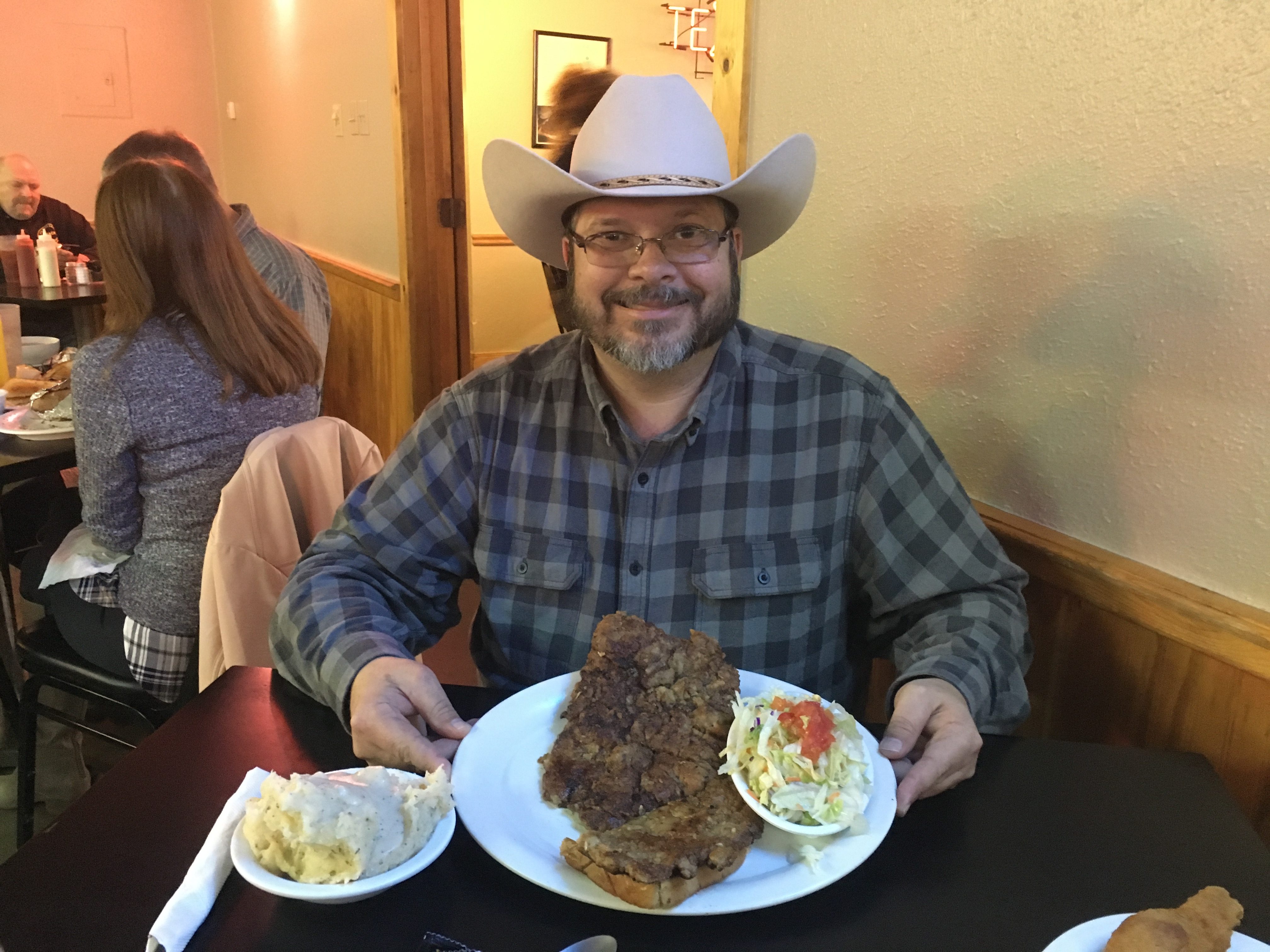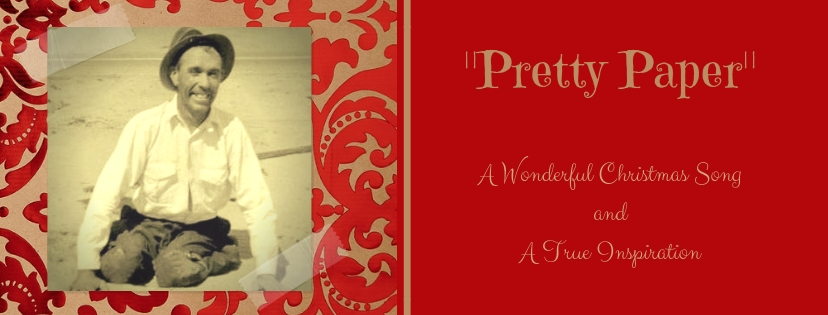
Merry Christmas, my friends! Christmas is only a little over a week away, and like everyone else, my family is busy enjoying all of the festivities of the season, as well as making preparations for the “Big Day.” This is our favorite time of the year, and with four children, there’s always a lot of work to be done, but it’s worth it, because they really do bring home the true meaning of Christmas.
Each year I try to find something Christmas related to write about for the month of December, and this year is no exception. As a Texan, I grew up with a great love of country music, especially those sung by the many artists from Texas, and Willie Nelson was always at the top of that list. During Christmas, the country stations would play Christmas music sung by country artists, and I was always intrigued by one of these songs in particular. Willie Nelson’s song, Pretty Paper, is beautiful and poignant, but with a touch of sadness, and as such, it always stood out to me, especially after I learned the story behind it. My mother was a huge Willie fan and one year she related how he came up with the idea for this Yuletide classic.
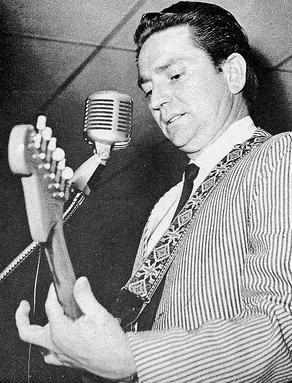
In the early 1960’s, as he was playing the bars and honkytonks of Fort Worth, Willie Nelson found himself in downtown Fort Worth, outside of Leonard’s Department Store. There, in front of the store’s big glass doors, was a man calling out, “pretty paper, pretty paper!” He was selling pencils, wrapping paper, and ribbons from a custom-made vest he wore, while dragging himself along the sidewalk on his hands and knees. On this particular day, the man wasn’t having much luck as the people shuffled past him as they walked in and out of Leonard’s, and the sight stuck with Willie.
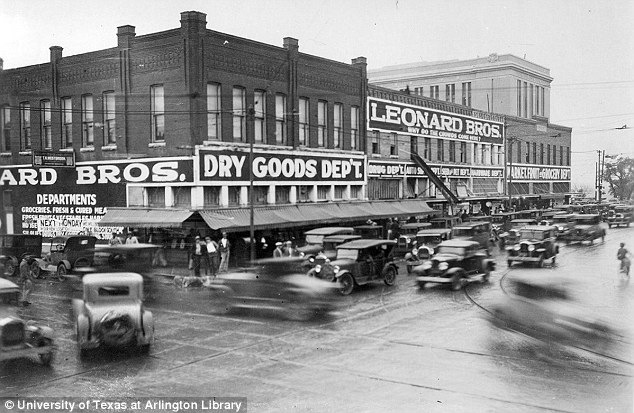
In 1963, after moving to Nashville, Nelson was walking around his farm when the disabled man in front of Leonard’s crossed his mind. He sat down to write the song, and twenty minutes later, the song Pretty Paper was born. “It was an easy song to write,” Willie Nelson said later. “The easy ones write themselves.” Roy Orbison recorded it in November of 1963, and Willie recorded his own version the following year. The song, with its beautiful melody and haunting words, has become a Christmas classic.

In 2013, the Fort Worth Star-Telegram revealed that the man’s name was Frankie Brierton, who was born with spinal meningitis and learned to get around on his hands and knees as a child. According to his daughter, Lillian Compte, he refused all government assistance. “He didn’t want to depend on anybody. He wanted to be on his own and take care of his family. He crawled around on his hands and knees, but we never did without.” He not only sold his wares in Fort Worth, but also in Dallas and Houston. Frankie Brierton died in 1974, and by all accounts, he never knew the song that he had inspired, but I know the song, and his story has certainly inspired me. Now, when I hear Pretty Paper, I’m not only moved by what a beautiful song it is, but also by the man it is based on,; a man who rose above his circumstances to live life on his terms and provide for his family.
I would like to thank each and every one of you for your readership and support. The success of Under the Lone Star is a real blessing and is due entirely to you. I wish you all a very Merry Christmas and a Happy New Year. Now saddle up, get out there, and enjoy all the Christmas joy that the great state of Texas has to offer.
©12/17/2018
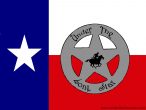
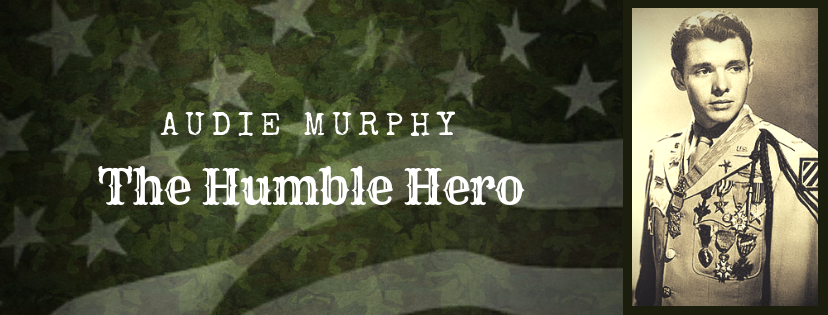
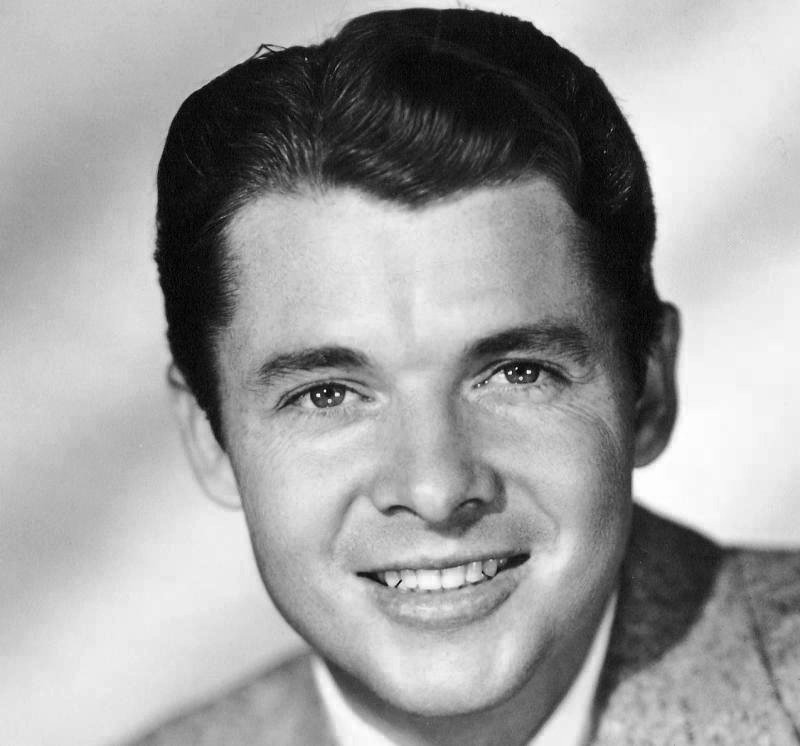 Audie Leon Murphy was born on June 20, 1925 in Kingston, Texas, to a family of sharecroppers. After the Japanese bombed Pearl Harbor on December 7, 1941, Murphy, like so many, felt the call to enlist in the military, but the Army, Navy, and Marines all rejected him for service due to being underweight and underage. Undeterred, Murphy, with the help of his sister, produced a falsified birth certificate and enlisted in the Army on June 30, 1942.
Audie Leon Murphy was born on June 20, 1925 in Kingston, Texas, to a family of sharecroppers. After the Japanese bombed Pearl Harbor on December 7, 1941, Murphy, like so many, felt the call to enlist in the military, but the Army, Navy, and Marines all rejected him for service due to being underweight and underage. Undeterred, Murphy, with the help of his sister, produced a falsified birth certificate and enlisted in the Army on June 30, 1942.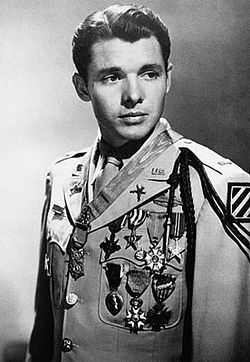 After shipping out for Europe, Audie quickly became a legend in the Army’s 3rd Infantry Division. He fought in nine engagements across the European theatre, was wounded three times, and is credited with over 240 enemy kills. Murphy is widely considered to be the best combat soldier produced by any branch of the military, rising from the rank of Private to Staff Sergeant, eventually receiving a battle field commission as a 2nd Lieutenant. On September 21, 1945, he was released from active duty, having received 33 awards and decorations for conspicuous valor, every one that the United States military has to offer, including the Medal of Honor.
After shipping out for Europe, Audie quickly became a legend in the Army’s 3rd Infantry Division. He fought in nine engagements across the European theatre, was wounded three times, and is credited with over 240 enemy kills. Murphy is widely considered to be the best combat soldier produced by any branch of the military, rising from the rank of Private to Staff Sergeant, eventually receiving a battle field commission as a 2nd Lieutenant. On September 21, 1945, he was released from active duty, having received 33 awards and decorations for conspicuous valor, every one that the United States military has to offer, including the Medal of Honor.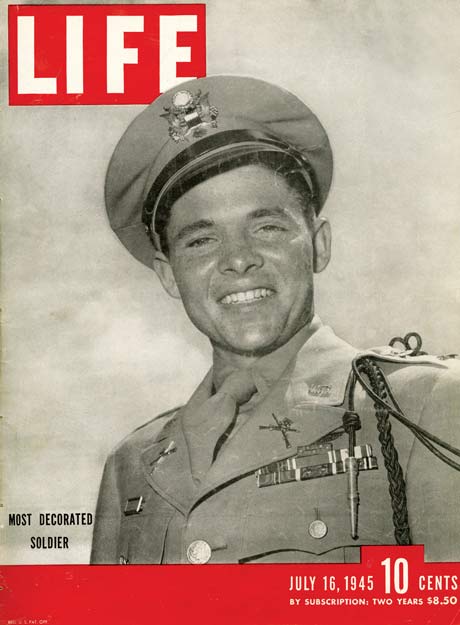 Audie Murphy returned home to a heroes’ welcome, even making the cover of Life Magazine, and it was this cover that caught the eye of movie star James Cagney, who reached out to Murphy and urged him to move to Hollywood and try his hand at acting. His first starring roll came in 1949, and in a career that spanned 25 years, he made 44 motion pictures, mostly westerns and war films. His autobiography, To Hell and Back, became a best seller and was turned into a movie, with Murphy portraying himself in the staring role. It became Universal’s highest grossing film until being surpassed by Jaws in 1975.
Audie Murphy returned home to a heroes’ welcome, even making the cover of Life Magazine, and it was this cover that caught the eye of movie star James Cagney, who reached out to Murphy and urged him to move to Hollywood and try his hand at acting. His first starring roll came in 1949, and in a career that spanned 25 years, he made 44 motion pictures, mostly westerns and war films. His autobiography, To Hell and Back, became a best seller and was turned into a movie, with Murphy portraying himself in the staring role. It became Universal’s highest grossing film until being surpassed by Jaws in 1975.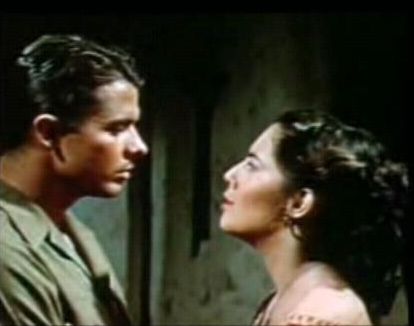


 The Devil’s Backbone is a scenic drive that follows a limestone ridge which runs from Blanco to Wimberley. It is wonderful drive that encompasses all the beauty that is found in the Hill Country. From the highway and several overlooks, one can look out over deep valleys where the limestone cliffs disappear beneath a canopy of live oak, pecan, and mesquite trees.
The Devil’s Backbone is a scenic drive that follows a limestone ridge which runs from Blanco to Wimberley. It is wonderful drive that encompasses all the beauty that is found in the Hill Country. From the highway and several overlooks, one can look out over deep valleys where the limestone cliffs disappear beneath a canopy of live oak, pecan, and mesquite trees. One such tale is of a hunter who had just climbed down from his tree stand at dusk and was walking back to his hunting cabin. While walking along the darkened trail, he sensed that he was not alone, and upon looking to his side, he saw a dark-skinned shirtless man less than ten yards from him. The man was clad in buckskin breeches and wore the war-paint of a Comanche brave.
One such tale is of a hunter who had just climbed down from his tree stand at dusk and was walking back to his hunting cabin. While walking along the darkened trail, he sensed that he was not alone, and upon looking to his side, he saw a dark-skinned shirtless man less than ten yards from him. The man was clad in buckskin breeches and wore the war-paint of a Comanche brave. Perhaps the strangest tale from the Devil’s Backbone is story of three men who were hiking one day when one of them became separated from the others. As he walked, he came upon a wolf, an animal that is not found in the area these days. As the man froze with both fear and curiosity, the wolf charged. As the wolf quickly approached his position, the man was certain he would soon be devoured, but as the predator leapt at him, instead of taking him down, the hiker felt the animal pass right through him. When the three friends were reunited, he breathlessly told his tale, but not surprisingly his two friends did not believe his story.
Perhaps the strangest tale from the Devil’s Backbone is story of three men who were hiking one day when one of them became separated from the others. As he walked, he came upon a wolf, an animal that is not found in the area these days. As the man froze with both fear and curiosity, the wolf charged. As the wolf quickly approached his position, the man was certain he would soon be devoured, but as the predator leapt at him, instead of taking him down, the hiker felt the animal pass right through him. When the three friends were reunited, he breathlessly told his tale, but not surprisingly his two friends did not believe his story.



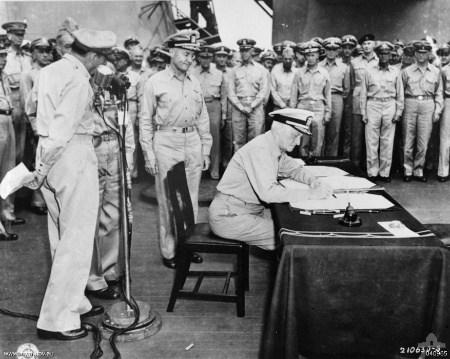

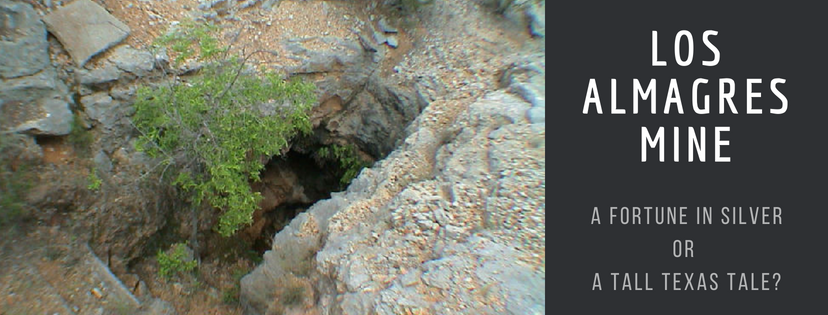
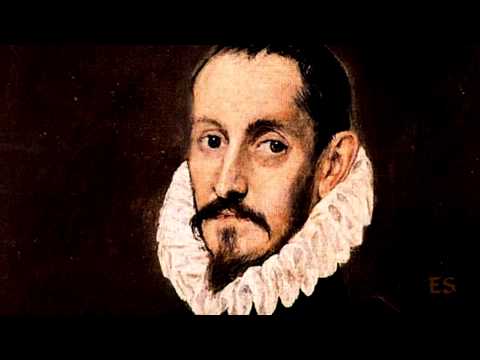


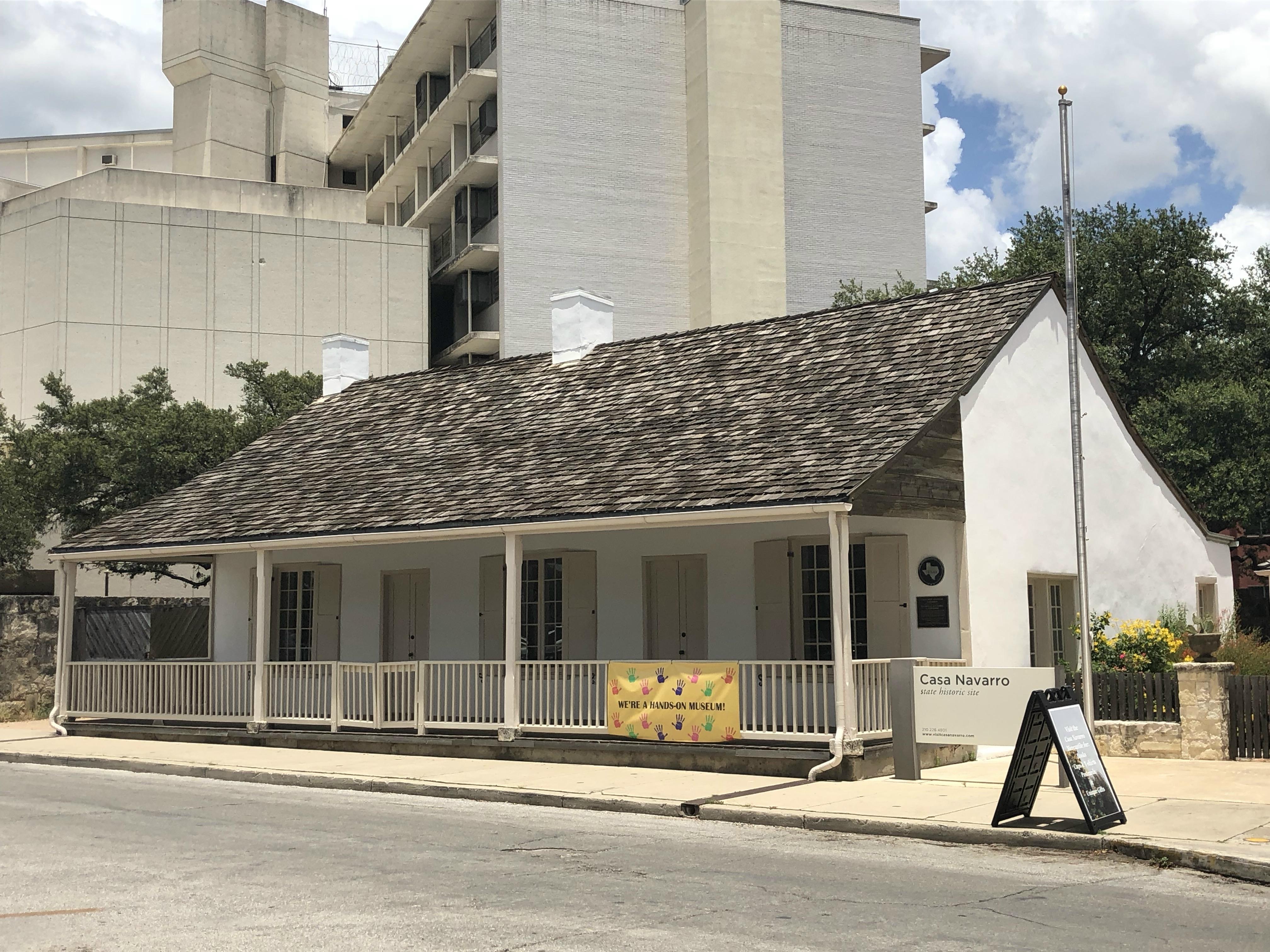 My family and I recently took a vacation to the Hill Country and spent a day in San Antonio. I’m not really a fan of big cities, but San Antonio is a great place to visit, as there are so many historic locations to see there. Over the years, I’ve probably visited the city at least fifty times, but we still manage to find interesting sites that we have never been to. Don’t get me wrong, the River Walk and the Alamo are still must-see destinations that I love going back to, but it’s always nice to discover that hidden treasure that has somehow been overlooked. On this trip that hidden treasure was the Casa Navarro State Historic Site.
My family and I recently took a vacation to the Hill Country and spent a day in San Antonio. I’m not really a fan of big cities, but San Antonio is a great place to visit, as there are so many historic locations to see there. Over the years, I’ve probably visited the city at least fifty times, but we still manage to find interesting sites that we have never been to. Don’t get me wrong, the River Walk and the Alamo are still must-see destinations that I love going back to, but it’s always nice to discover that hidden treasure that has somehow been overlooked. On this trip that hidden treasure was the Casa Navarro State Historic Site. Jose Antonio Navarro was a leading citizen and advocate of early Texas. He was self-educated, becoming an expert in the law of the Mexican colony, and was one of the first supporters of Stephen F. Austin and his plan to colonize the mostly uninhabited land. During the fight for Texas Independence, he was a soldier, statesman, and voice for the cause, keeping the spark burning during the dark days after the fall of the Alamo and Goliad. At Washington-On-the-Brazos, he was one of the signers of the Texas Declaration of Independence, and later signed the Constitution of the Republic of Texas. His work didn’t stop once Texas won its independence, in fact, that was merely where his service began. He served as a representative for the Republic of Texas and as a State senator after the state was annexed by the United States, helping to draft the state constitution. Navarro doesn’t get the recognition of a Crockett, Houston, or Bowie (who was his nephew by marriage), but the work that he did was vital to not only independence, but also to the building of everything that Texas became after.
Jose Antonio Navarro was a leading citizen and advocate of early Texas. He was self-educated, becoming an expert in the law of the Mexican colony, and was one of the first supporters of Stephen F. Austin and his plan to colonize the mostly uninhabited land. During the fight for Texas Independence, he was a soldier, statesman, and voice for the cause, keeping the spark burning during the dark days after the fall of the Alamo and Goliad. At Washington-On-the-Brazos, he was one of the signers of the Texas Declaration of Independence, and later signed the Constitution of the Republic of Texas. His work didn’t stop once Texas won its independence, in fact, that was merely where his service began. He served as a representative for the Republic of Texas and as a State senator after the state was annexed by the United States, helping to draft the state constitution. Navarro doesn’t get the recognition of a Crockett, Houston, or Bowie (who was his nephew by marriage), but the work that he did was vital to not only independence, but also to the building of everything that Texas became after. The Casa Navarro State Historic Site is the property that Navarro purchased in 1832 and consists of three structures, one of which was his original home site, and is situated on 1.5 acres. The site is not only an example of how homes in the mid-nineteenth century were constructed, but it also gives a wonderful insight into a man who gave much to this wonderful state. Other than the original home, which was built in 1856, there is a two-story building that many believe served as his law office and a store, and another single-story structure called the kitchen, though there is some doubt as to whether that was ever its function.
The Casa Navarro State Historic Site is the property that Navarro purchased in 1832 and consists of three structures, one of which was his original home site, and is situated on 1.5 acres. The site is not only an example of how homes in the mid-nineteenth century were constructed, but it also gives a wonderful insight into a man who gave much to this wonderful state. Other than the original home, which was built in 1856, there is a two-story building that many believe served as his law office and a store, and another single-story structure called the kitchen, though there is some doubt as to whether that was ever its function.

